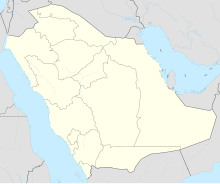Wabar
Coordinates: 21 ° 30 ′ 9.2 " N , 50 ° 28 ′ 26.7" E
The Wabar Crater ( Arabic وابر, DMG Wābar ) are impact craters in Saudi Arabia that are visible on the earth's surface and are caused by a meteorite impact .
The discovery
The vast desert in southern Saudi Arabia, also known as Rub al-Chali or Empty Quarter , is one of the most deserted places on earth. In 1932, the British researcher Harry St. John "Abdullah" Philby , father of the spy Kim Philby , searched for the city of Iram , which in Sura 89 of the Koran said it had been destroyed by God because the inhabitants turned to the Prophet Hūd would have resisted. In February 1932, after roaming the area for a month, he found a patch of ground, about half a square kilometer, covered with chunks of white sandstone , black glass, and pieces of an iron meteorite . There were two large depressions there, some of which were filled with sand. An analysis of the iron chunk showed that the piece consisted of 90% iron , the proportion of nickel was 5%, the rest contained various elements, including copper and cobalt and 0.0006% (6 ppm) - an unusually high concentration - of Iridium .
The location
The Wabar area covers an area of around 500 by 1,000 meters; the latest maps show three conspicuous, almost round craters; two of them have already been observed by Philby, one with a diameter of 116, the other 64 meters, the third crater has a diameter of eleven meters and was discovered in the 1990s during the second Zahid expedition. All impact craters have an “instant rock” subsurface, which was formed from the existing sand as a result of the impact. Today all three craters are almost completely filled with sand.
On the surface there was partly the above-described “instant rock” or impactite similar to a sandstone, and it was also covered by black glass slag and glass beads. The impactite was in the form of coesite , a high pressure modification of quartz . Since the impact did not penetrate to the basement , but was slowed down by the sand, the Wabar area is very valuable for research.
The occurrence of iron fragments also indicated a meteorite impact, especially since there are no iron deposits in the area. The iron was in the form of fist-sized broken balls and smooth fragments on the surface, weathered by sand. The largest piece was recovered in 1965, it has a mass of 2.2 tons. It is known as the "Camel's Hump" and was exhibited at King Saud University in Riyadh ; today it is in the new National Museum of Saudi Arabia .
The appearance of the impact area suggests that the celestial body turned at a shallow angle but moved at the typical speed of 40,000 to 60,000 km / h. Its total mass was more than 3,500 tons. Due to the shallow angle of impact, the distance covered in the atmosphere was longer than at a steeper angle. Apparently the meteorite broke into four parts before the impact.
Dating
A fission-track analysis of glass fragments showed that the impact in front of thousands have taken place of years had, however, the fact that the craters were filled considerably with sand since its discovery by Philby, suggests that they are much younger. A Thermolumineszenzdatierung by Prescott et al. (2004) suggests that the impact area is no older than 260 years.
See also
Web links
Individual evidence
- ↑ Wabar crater in the Earth Impact Database ( memento of the original from October 2, 2013 in the Internet Archive ) Info: The archive link was inserted automatically and has not yet been checked. Please check the original and archive link according to the instructions and then remove this notice.
- ↑ THE MINERALOGICAL MAGAZINE, No. 142. 1933 pdf minersoc.org, accessed on November 21, 2013
- ↑ Bilkadi, Z. (1986) “ The Wabar Meteorite ( Memento of the original from October 24, 2008 in the Internet Archive ) Info: The archive link was inserted automatically and has not yet been checked. Please check the original and archive link according to the instructions and then remove this notice. ", Saudi Aramco World , 37 (6), p. 26-33
- ↑ Prescott, JR, Robertson, GB, Shoemaker, C., Shoemaker, EM and Wynn, J. (2004) "Luminescence dating of the Wabar meteorite craters, Saudi Arabia", Journal of Geophysical Research , 109 (E01008), doi : 10.1029 / 2003JE002136

